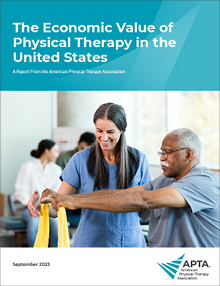By using this site, you are consenting to our use of cookies. To find out more visit our privacy policy.
The methodology used to create "The Economic Value of Physical Therapy in the United States" incorporates an extensive review of research literature on the selected conditions and interventions, input from subject matter experts, and established health economics modeling. This approach allows for cost-benefit estimates that include the social and environmental effects borne by society as a result of a care delivery option.
In this report, net costs aren't simply the billed costs of an intervention; they include direct nonintervention costs and indirect costs as well. These costs are weighed against the net benefit of an intervention, which was calculated by multiplying the value of a statistical life year, or VSLY, expressed in U.S. dollars, by the quality of adjusted life years associated with the intervention. Viewed in this way — an approach that incorporates the economic benefits of quality of life improvements rather than simply comparing costs — physical therapist services were repeatedly found to be more cost-effective than alternative courses of care.
For a detailed description of the report's methodological foundation, see "Approach and Methodology," beginning on Page 9 of the report.
